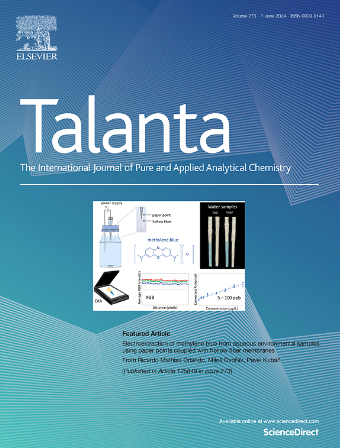Enhanced chemiluminescence of luminol via In2S3/MXene composite as a novel Co-reactant accelerator for UV-filter Benzophenone-3 determination
IF 5.6
1区 化学
Q1 CHEMISTRY, ANALYTICAL
引用次数: 0
Abstract
In this study, a novel In₂S₃/MXene composite was developed as a co-reactant accelerator to enhance the chemiluminescence (CL) performance of the classical luminol-H₂O₂ system. The In₂S₃ and MXene heterojunction catalyzed the CL reaction through synergistic effect, facilitating the generation of reactive oxygen species and increasing CL intensities. This enhanced system was applied for the first time to detect an ultraviolet (UV) filter-benzophenone-3 (BP-3) by leveraging its light absorption property. The proposed CL method exhibited excellent sensitivity, with a linear detection range for BP-3 spanning from 1 × 10⁻11 mol/L to 1 × 10⁻⁹ mol/L and a detection limit of 5.28 × 10⁻12 mol/L (S/N = 3). The method was validated by successfully detecting BP-3 in real water samples, demonstrating its potential in monitoring UV-absorbing pollutants in environments.

求助全文
约1分钟内获得全文
求助全文
来源期刊

Talanta
化学-分析化学
CiteScore
12.30
自引率
4.90%
发文量
861
审稿时长
29 days
期刊介绍:
Talanta provides a forum for the publication of original research papers, short communications, and critical reviews in all branches of pure and applied analytical chemistry. Papers are evaluated based on established guidelines, including the fundamental nature of the study, scientific novelty, substantial improvement or advantage over existing technology or methods, and demonstrated analytical applicability. Original research papers on fundamental studies, and on novel sensor and instrumentation developments, are encouraged. Novel or improved applications in areas such as clinical and biological chemistry, environmental analysis, geochemistry, materials science and engineering, and analytical platforms for omics development are welcome.
Analytical performance of methods should be determined, including interference and matrix effects, and methods should be validated by comparison with a standard method, or analysis of a certified reference material. Simple spiking recoveries may not be sufficient. The developed method should especially comprise information on selectivity, sensitivity, detection limits, accuracy, and reliability. However, applying official validation or robustness studies to a routine method or technique does not necessarily constitute novelty. Proper statistical treatment of the data should be provided. Relevant literature should be cited, including related publications by the authors, and authors should discuss how their proposed methodology compares with previously reported methods.
 求助内容:
求助内容: 应助结果提醒方式:
应助结果提醒方式:


